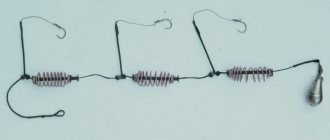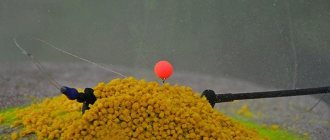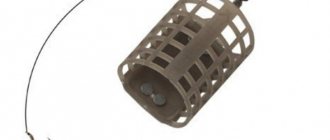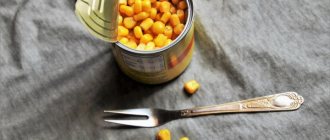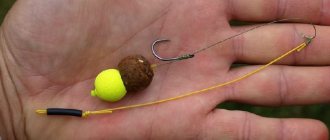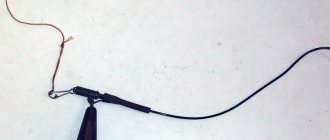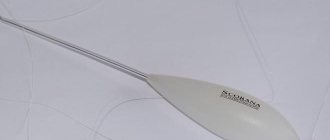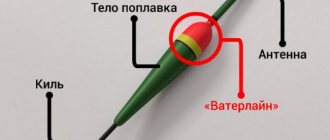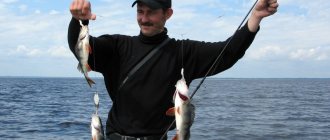Bombarda (or sbirulino) is a professional fishing device designed for spinning fishing. Used in conjunction with conventional lightweight equipment to increase the casting distance of a spinning rod.
The Bombard's rig is catchy in that it makes it possible to throw many types of gear, for example: small wobblers, silicone fry or various kinds of spinners far from the shore.
In addition, a similar design of the float and fishing with a bombard allows you to use any bait in any type of reservoir and at different depths.
Main types of bombards
In order to use the bombard correctly and effectively, you must understand the principles of operation of the device and know what types of this device there are.
Today, sbirulino is used by amateur fishermen more and more often, so it is not surprising that their range is growing.
Despite their external similarity, bombards have completely different characteristics, such as volume, weight and buoyancy parameters.
Floating and sinking bombard
Based on the level of buoyancy, bombards are divided into three types:
- floating on the surface of a reservoir;
- completely drowning (drowning);
- gradually sinking (drowning).
Loaded and empty
By type, bombards are easily divided into the following groups:
- With lead sinker. Typically, lead weights are used to effectively weight bombards. The float is also provided with an empty cavity.
This model allows the fisherman to choose the volume of water to fill the inside of the float.
- With an empty internal cavity.
Every fishing enthusiast chooses for himself which model to prefer in a given case. Usually it all depends on the characteristics of fishing (winter or summer, shallow or deep).
Tactics and fishing techniques
Successful fishing for sabrefish is based on knowledge of the habitats and habits of this fish. The fishing technique itself is the same as fishing with a bombard for any other surface fish. The essence is the same - deliver the bait to the right place and horizon, give it the right action (if it is artificial).
Small sabrefish feed on larvae, insects and crustaceans until about three years of age, and then switch to eating fry, becoming almost a pure predator. A flock usually contains individuals of approximately the same age and size. In spring or autumn, saberfish gather in large flocks, but in summer they sometimes stand scattered, but still in their favorite places.
Search for fish
Fishing with a bombard for sabrefish is, first of all, searching for the place where this fish lives. On specific bodies of water, such points are known, since they usually do not change from year to year. Usually these are areas of holes near riffles or on the border of streams, water areas behind riffles and islands, the border of bays and open water. Therefore, before heading to a new body of water, it is better to make inquiries from locals or on fishing forums where saberfish are caught in a specific water area.
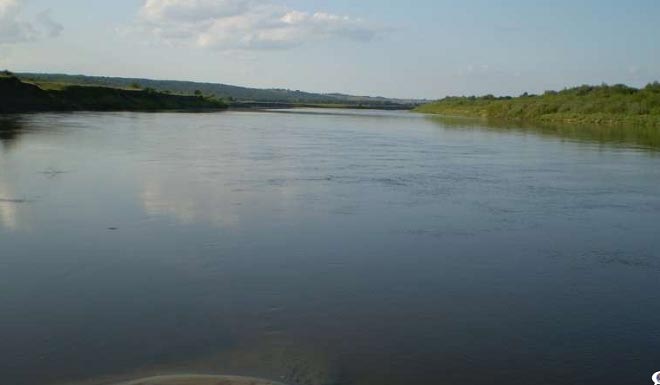
Seasonality
You need to look for saberfish in the spring upstream from their habitats. At this time, saberfish can be found where they do not appear at other times of the year - in smaller channels and rivers. Usually this fish likes to live on vast rivers and reservoirs. We search in standard places - on sandy slopes, beaches, underwater navels, on a current or next to a stream. The chekhon loves the same places as the asp sheresper.
In summer, fishing for saberfish is less productive - the fish return to their permanent habitats and remain relatively sparse in them. Here you need to walk and search; you won’t be able to fish all day from one point. The only way to get caught is during the flight of the mayfly.
In the fall, saberfish again increase their activity, feed heavily, and gather in large flocks before winter. During this fertile time, you need to look for cauldrons by splashing fish or feeding seagulls. If successful, you can count on significant catches of sabrefish.
General article about the features of catching sabrefish
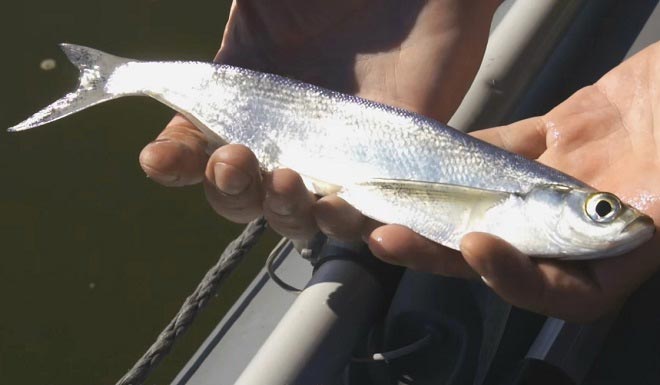
Assembling a fishing rod with a bombard

As a rule, if there is a need to equip a bombard, then the fishing rod should be selected taking this element into account. There is only one way to assemble such a spinning rod.
First of all, when choosing a fishing rod, you need to remember that you will be casting the fishing rod over long distances, so the bombard should be the optimal size for you.
The standard length of the stick is from 3 to 6 m.
Then a parabolic rod action is suitable, and the shape of the test is determined by the weight of the float itself. In this situation, a load weighing about 45-65 grams is sufficient.
For this type of fishing rod, choose a standard spinning reel model.
The spool must hold at least 100 meters of fishing line of medium or large diameter, and the fractional brake is adjusted immediately before the start of fishing.
Bombard fishing does not involve the use of all types of fishing lines - only monofilament or braided options are suitable. If you want to cast a float over long distances, then it is preferable to buy a braided fishing line.
The bombard itself and the tackle are chosen based on the type of fish you plan to catch. Also, the float is selected based on the type and weight of the fish. To avoid twisting of the fishing line while fishing, you must use a swivel.
You also need not a simple hook, but a special one - made of durable materials and with large pointed stings.
But even if you manage to choose the right accessories for fishing such a difficult task as fishing with a bombard, you still need to know how to attach this very bombard to a fishing tool.
fishing line
In this case, monofilament or braided fishing line can be used, but you must take into account the fact that the thickness also changes depending on the type you choose. Thus, braided line should have a thickness of 0.15 to 0.17 mm, while monofilament should be 0.18-0.25 mm thick. The advantage of the “braid” is that it does not stretch, and therefore the fish bite remains noticeable even at a fairly long distance. Monoline can be used in the process of fishing at short distances. It is worth noting that monofilament helps in dampening the jerks of fish during the fishing process.
Bombard equipment
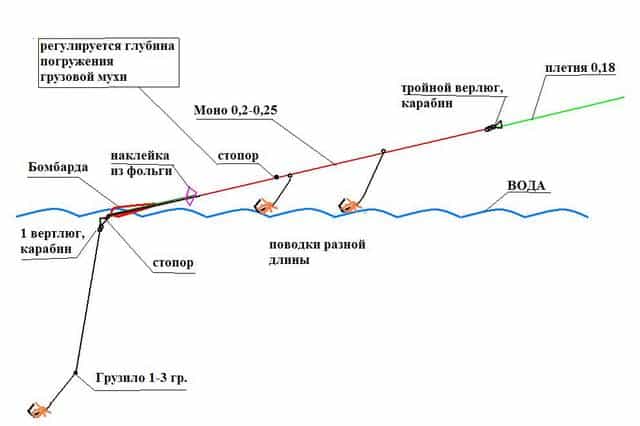
There are many methods for installing bombard rigs using sbirulino. We invite you to consider the traditional option of installing a bombard:
We place the reel on the fishing rod and wind the main line onto it. We attach a float, and tie a buffer made of a piece of foam plastic to the fishing line. We attach swivels to the fishing line.
We hook the leash to the outer hook of the swivel. We attach a hook with the prepared bait onto it.
Some fishermen prefer to make bombarda (sbirulino) themselves. Let's see how they do it.
Sbirulino
Sbirulino floats come in a variety of sizes and weights, but it is best to buy floats whose weight will fluctuate around forty grams.
Types and types
By type, these floats are:
- floating;
- slowly sinking;
- sinking quickly.
They are used for catching fish at different water levels in reservoirs. For example, trout fish are usually found on the surface of the water, so floating bombards should be used to catch them, and pike perch most often live on the bottom, so it would be wise to use a fast-sinking float to catch them.
Based on the position of the built-in weight in bombards, the following varieties are distinguished:
- Classiche. This is a float that is considered a classic. The weight in it is located in the lower region of the “body” of the tackle. Due to this arrangement of the weight, this bombard enters the water along a vertical line;
- Moretto. The weight in this float is located throughout its “body”. It is used for fishing in mid-water levels or on the bottom. Due to the fact that the weight of the weight is evenly distributed along the entire length of the float, it always enters the water very smoothly and behaves smoothly when moving;
- Competition The weight in this float is located in its very center, so the bombard has a parallel position in relation to the fishing line during retrieving and entering the water, which makes it very sensitive to bite. In addition, by moving the fishing rod and retrieving movements, you can add additional speed to the bait, causing the bombard to oscillate near it;
- Match. The weight in these floats has an elongated shape and is located in the upper zone of the float. When wiring, their position is very close horizontally. Such a bombard is usually immersed in water with its upper part and immediately sinks to the bottom;
- Magic . The weight is located in different parts of the float - upper and lower. This is the most sensitive bombard. When entering the water, it has a horizontal position.
Leash
The length and material of the leash are selected depending on the desired catch. Despite this, there is a classic version of the leash, which is made from a fluorocarbonate piece of fishing line with a diameter of 0.20 mm and a length of 1.5 meters.
Swivel
Swivels are used to equip bombards so that the fishing line that holds them does not get tangled or twisted, since spinners often tangle it. It is best to use a triple swivel for a bombard, the size of which will be from fifteen to twenty.
Hooks
Hooks should be as strong as possible and have very sharp tips. If the catch will be made with live bait, then the hook should have a long shank and a small “beard”.
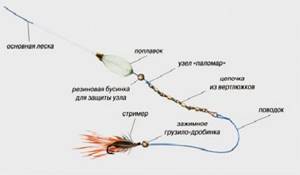
The size of hooks should be selected depending on what kind of fish will be caught and what its average size is.
Step-by-step instructions for tying rigs:
- Attach a float to the main line, which should be slightly limited in its movements along the line. To do this, it must be equipped with two stoppers, which are fixed at the top and bottom of the float. This is necessary so that the float does not hit the swivel when casting.
- Attach the swivel to the fishing line.
- After the windlug, you need to mount a leash, which should be from one and a half to three meters long. At the very tip of the leash you should attach a bait that was prepared in advance.
- When using a bombard for the first time, it is advisable to use only one hook. This is necessary so that the fisherman can test the gear in action and understand not only the general technique of such fishing, but also all the little details. After this, you can safely use two or three hooks.
The choice of modern bombards should be made based not only on the type of fish, but also on the bottom of the reservoir in which the fishing will take place, its topography, the degree of softness or hardness and the type of current.
For example, sbirulino, whose weight will be about ten grams, is better used in reservoirs with a large current, and sbirulino with a weight of thirty grams will be convenient for fishing in water with a quiet current.
Making your own bombard
Experienced fishermen claim that a bombard made at home works many times more efficiently than one purchased from a fishing store.
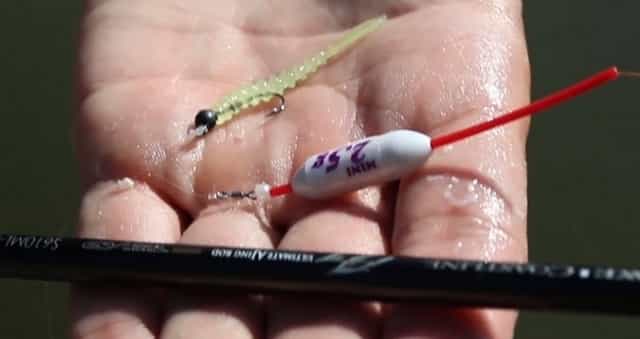
Source materials for making sbirulino yourself:
- large float of any shape;
- a piece of dense foam;
- syringe without needle.
How to make a bombard with your own hands:
The basis of our bombard will be a regular float, which is weighted with lead shot. You also need to take a piece of polystyrene foam and use a hacksaw to cut it out to the required size and shape.
Now you need to cover the float with bright waterproof paint, thread a plastic tube inside and carefully string a lead sinker onto it.
Don't forget to secure the entire structure with superglue. Thread the main line through the tube with a hole made in advance.
If you prefer to make a bombard, for example, from a syringe, then you need to make a recess for the fishing line, thread it inside and secure it.
Of course, there are other ways to make fishing sbirulino, but at the amateur level the above methods are quite suitable.
Bombard equipment for sabrefish
You should catch sabrefish using a spinning rod. The best bait to use is a regular red worm, which should be thrown directly into schools of fish. Wiring should be done very slowly with slight jerks.
To catch sabrefish you need to use the following equipment:
- fishing rod 2.5 m long;
- spinning reel with spool size 2000;
- main line braided with a diameter of 0.14 mm;
- line for fluorocarbon leashes with a diameter of 0.16-0.19 mm;
- hooks with numbers ten.
The best baits for saberfish are:
- pearl barley porridge;
- twister;
- worm;
- maggot;
- mastyrka.
Chekhon usually bites better on animal baits than on plant baits.
